BLOG
How to Increase Conversion Rate with 14 Proven Methods
Published: Nov 11, 2022
Increase website conversions
with Yieldify
Schedule your demo
How can I increase my website conversion rate? That’s a question on the mind of most digital marketers.
Maybe you’re driving good traffic from your digital marketing channels – whether that’s from paid ads, organic, search engine optimization, email or social – but you’re still not converting enough of those visitors into customers.
With the average ecommerce conversion rate between 1.84%-3.71%, taking steps to improve your rate by as little as a half percentage point can be a massive win for an online business.
In this blog I’ll outline 14 ways you can increase your conversion rate if you’re not happy with it. These are the steps hundreds of our clients have taken to successfully increase their own conversion rates.
The steps follow a chronological approach and fall into four key categories:
- Set your strategy
- Personalize your customers’ journeys
- Test, test and test again
- Assess results, find new opportunities, revise strategy
If you’re looking to specifically convert more website visitors into email & SMS subscribers, then check out our post covering 12 of the best lead generation tools on the market.
14 Ways to Boost Conversions on your Website
- Set your strategy (1-2): Clearly define your goals before you start making optimizations. Build the foundation of your conversion rate strategy by following these critical steps.
- Personalize your customers’ journeys (3-9): Once you’ve outlined your goals, it’s time to add personalization campaigns to your website. Follow these 7 tried-and-tested steps to convince potential customers to buy your product or service.
- Test, test and test again (10-12): You’ve added campaigns to your website – but how do you know they’re working? Analyze the performance of your campaigns with 3 common ecommerce testing methods.
- Assess results, find new opportunities, revise strategy (13-14): The end of a test marks the beginning of a new cycle. Evaluate performance, identify areas for improvement and continue lifting your website’s conversion rates with these final two tips.
How to increase conversion rates at a glance
- Set your goals
- Analyze your existing customer journeys
- Use social proof
- Improve user navigation
- Embed USP banners
- Leverage customer testimonials
- Deploy countdown timers
- Reduce browse abandonment
- Tackle cart abandonment
- Incremental testing
- A/B testing
- A/B/n testing
- Optimize your campaigns
- Set best-performing campaigns to 100% of visitors
Set your strategy
1. Set your goals
Before you take any steps to increase your website’s conversion rate, ask yourself: what does success look like?
You’re reading this blog, so obviously you want to lift conversions and increase revenue – but how do you want to achieve that? Here are five common ecommerce conversion goals:
- To gather deeper customer insights
- To streamline website navigation
- To maximize sales during promotional periods
- To collect more leads
- To increase their return on ad spend (ROAS)
With Yieldify’s fully managed service, one of our industry experts will give you strategic advice to help you define your objectives.
2. Analyze your existing customer journeys
Customer journey analysis is a key step in improving your conversion rate.
You need to dive deeper into your customer data and conversion metrics to learn where your customers are buying – and where they’re not. Once you know how customers are behaving on your site, you can form hypotheses about how to increase your conversion rate.
It’s easier to understand your customers with a complete view of their journeys – which Yieldify offers with Sunburst charts. Sunburst goes beyond Google Analytics by providing a multidirectional view of a customer journey, which helps you to:
- Understand how users navigate from one page to another
- Identify looping behaviors
- Identify high-bounce pages
- Identify the top conversion paths
- Unlock 80% more data vs Google Analytics
Made in Design analyzed their customer journeys using a Yieldify Sunburst chart and realized customers arriving from PPC ads were rarely converting. They created personalized campaigns specifically for PPC customers and lifted conversion rates by 18%.
Personalize your customers’ journeys
3. Use social proof
Social proof is a psychologically powerful marketing tool that speaks to our innate desire to belong to the tribe. When we see our friends, peers and idols wearing the latest on-trend brand or using the latest cutting-edge technology, we’re naturally drawn to purchase those items as well.
For ecommerce marketers looking to increase conversion rates, social proof is a go-to tactic that can help you to:
- Validate customer interests
- Drive urgency
- Highlight stock scarcity
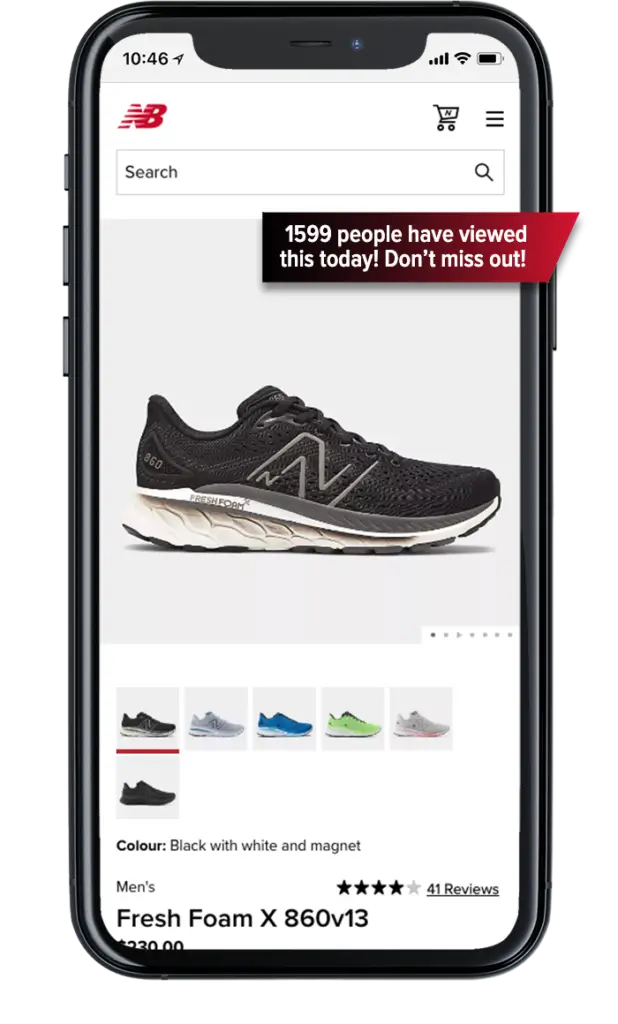
With Yieldify, New Balance used social proof to lift website conversions among mobile users by 10%.
4. Improve user navigation
According to a report from KoMarketing, 37% of shoppers say poor navigation is enough of a problem to make them leave a website. If your online store isn’t easy to navigate, then your website conversion rate will inevitably suffer.
To make your site more user-friendly and improve your conversion funnel, create and embed website experiences that help shoppers find the products they’re looking for. For example, you could:
- Provide basket reminders to returning shoppers
- Guide customers to relevant category pages
- Show recently viewed products
- Provide product recommendations based on customer preferences
- Direct customers to complementary products – increasing average order value as well as conversions
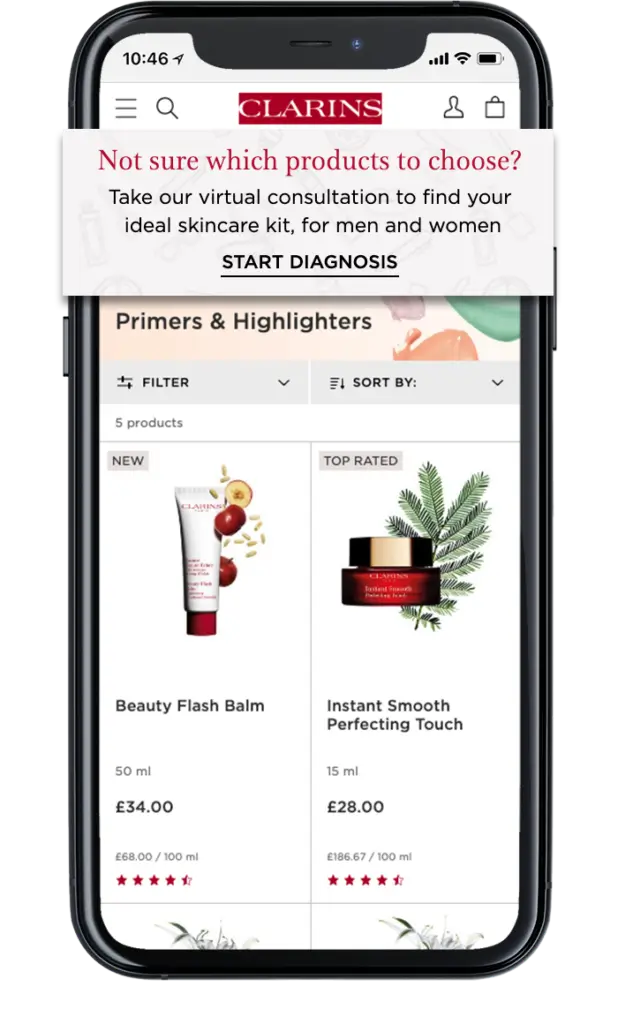
The more you can replicate the in-store experience online, the better. For example, Clarins used Yieldify to guide shoppers to a virtual skincare consultation – which resulted in a 11% increase in conversions.
5. Embed USP banners
In a crowded market, you need to differentiate yourself from your competitors with a clear value proposition. Your USPs will give customers a reason to shop with you and not your competitors, so spotlight them in embedded site banners.
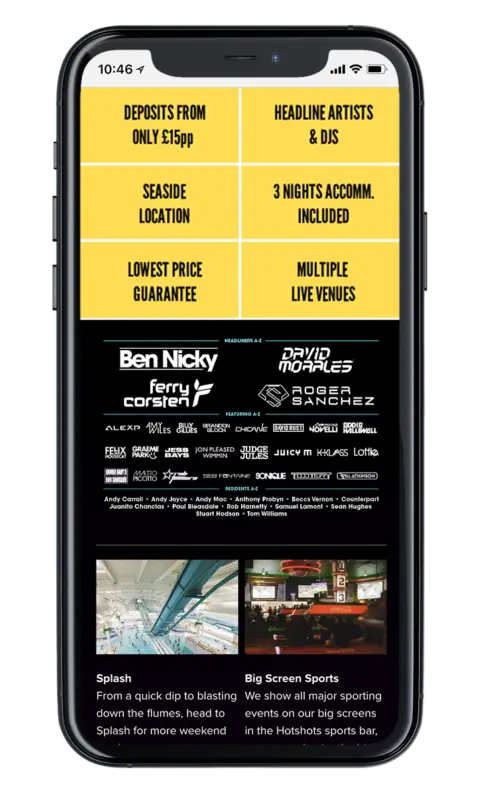
Not only will USP banners increase short-term conversions, they’ll also streamline the user journey and increase customer loyalty, which will boost conversion rates in the long run.
6. Leverage customer testimonials
Customer testimonials are an excellent way to build credibility and convert interest into sales. According to Big Commerce, 92% of customers read reviews before buying and 72% say positive testimonials increase their trust in a business.
Your prospective buyers are more likely to trust unbiased claims from real-life customers than your own marketing material – so use them to back up claims about your product or service.
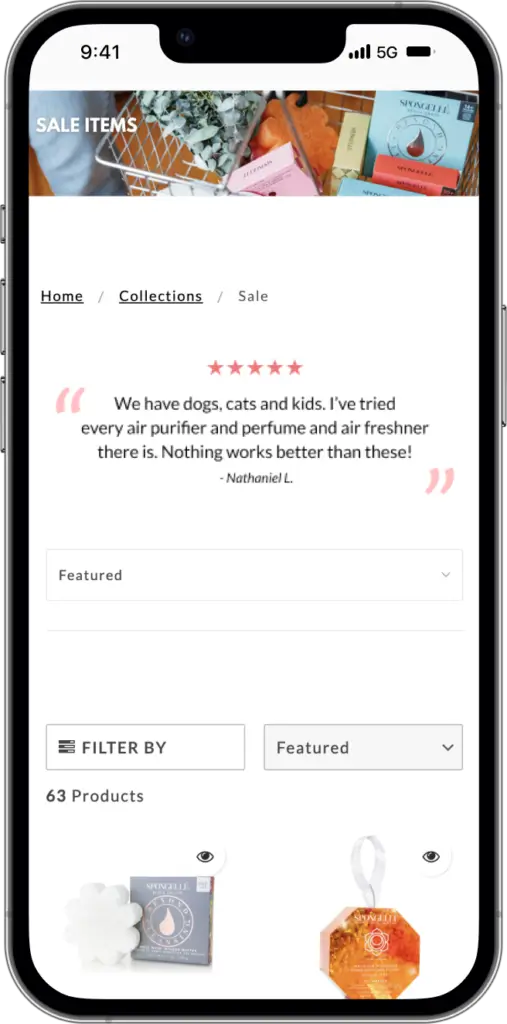
For example, Spongelle, an up-and-coming personal care brand, embedded a rotating GIF featuring customer testimonials into their site using Yieldify – resulting in a 14% uplift in customer conversions.
7. Deploy countdown timers
For customers who regularly visit your site, it’s a case of when – not if – they’re going to buy. But how do you drive urgency and convince them to buy now, not later?
Countdown timers are a great place to start – a survey by Whichtestwon showed that countdown timers increase revenue by 9% on average.
With countdown timers you can:
- Highlight the cut-off point for next day delivery
- Highlight when your sale period ends
- Highlight how long your customer has to redeem a discount code
You can use countdown timers everywhere on your website from the homepage through to checkout. They’re also a great way to increase conversions from your email marketing.
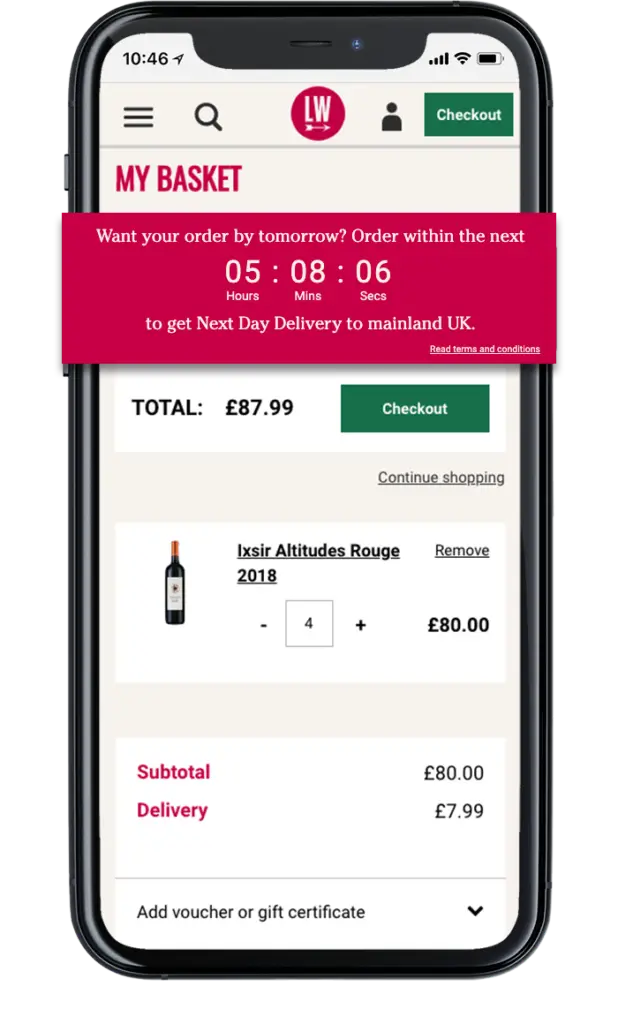
Laithwaites, a leading D2C wine company, used Yieldify to embed next-day-delivery countdown timers into their basket pages and lift conversions by 8%.
8. Reduce browse abandonment
Browse abandonment is a major problem for ecommerce marketers. According to Zenreach data, 70% of first-time site visitors never return to your site once they leave.
To combat this problem, run campaigns that respond to exit intent behaviors, including:
- After a set period of inactivity
- When a customer moves their cursor above the nav bar
- When a customer changes tabs
- When a customer copies the product name and opens a new tab
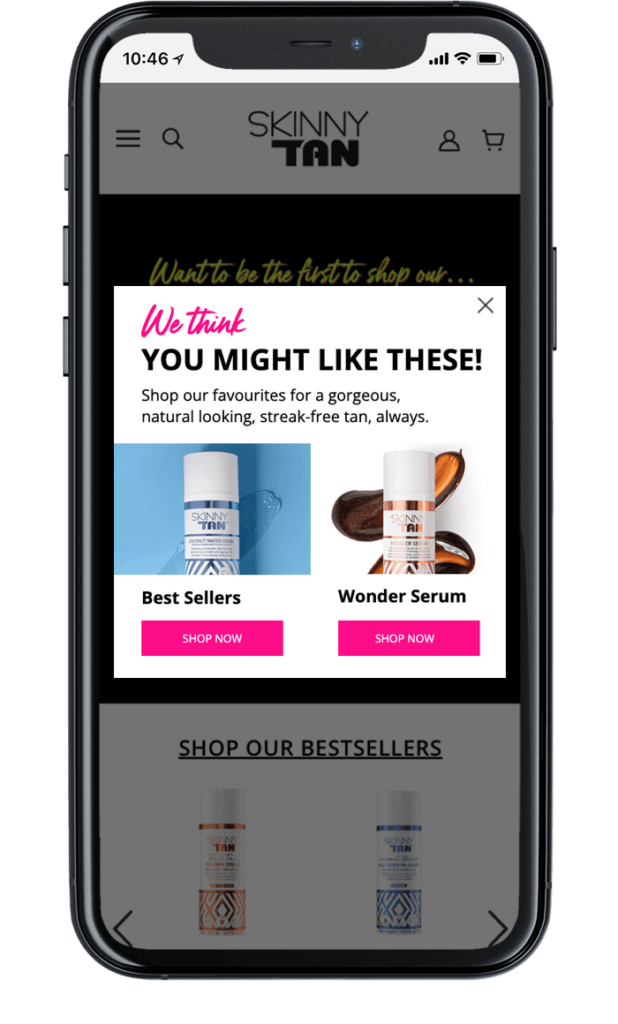
Stop shoppers leaving your site by re-engaging them with exit-intent campaigns. Skinny Tan increased conversions with Yieldify by 4% by guiding customers displaying exit intent to popular category pages.
9. Tackle cart abandonment
When a customer adds an item to their basket, you know they’re considering buying – but the sale is still far from guaranteed. Indeed, the average cart abandonment rate, just like browse abandonment, is 70% across all industries.
The challenge for ecommerce marketers is to incentivize shoppers to check out now, not later – which you can achieve through these five tactics:
- Use urgency messaging
- Provide discount codes
- Spotlight “buy now, pay later” options
- Embed trust badges – e.g. money back guarantees
- Run “welcome back” campaigns
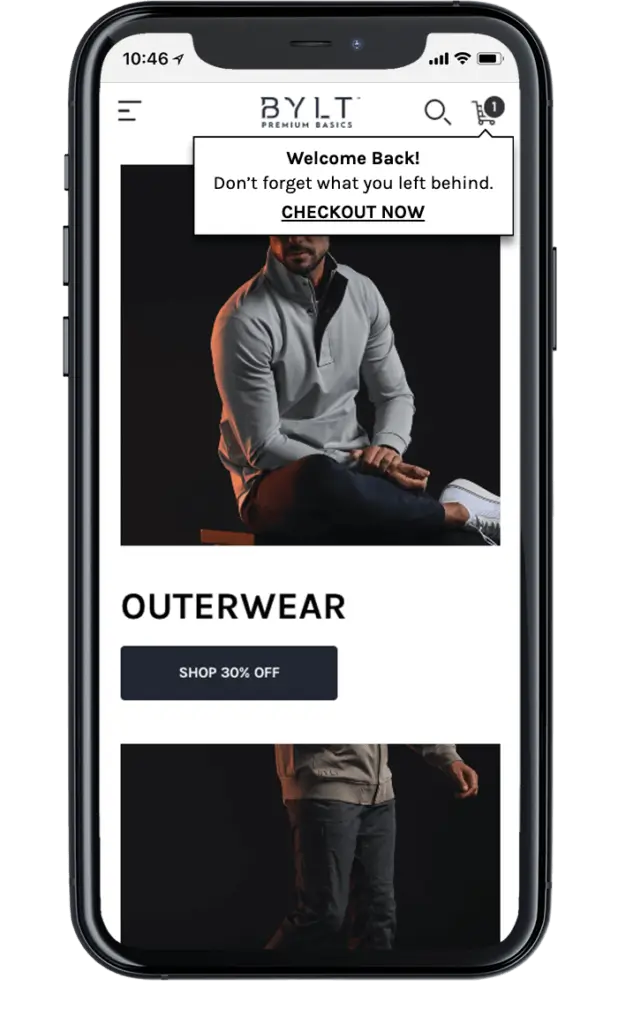
Test, test and test again
10. Incremental testing
Incrementality testing is referred to as the “North Star” of marketing. You can use incremental tests to accurately analyze the conversion rate impact – whether it’s positive, neutral or negative – of any marketing initiative.
In a typical incremental test, you’ll keep your site the same for 50% of your audience and change a single element for the other 50%.
For example, California fashion brand BYLT Basics ran an incremental test with Yieldify to re-engage returning visitors. They showed 50% of their returning customers a promotional banner directing them to the sale page, and left the website unchanged for the other 50%. The result? A massive 34% increase in conversion rates.
11. A/B testing
A/B testing is a must when you’re working to improve your conversion rate optimization methods. Successful A/B testing can bring a 50% increase in the average revenue per unique visitor for ecommerce sites – so no wonder 77% of organizations are running A/B tests to increase their conversion rates.
With A/B testing you can optimize various aspects of your website by dividing your traffic into two groups of 50%, showing them different experiences to uncover which variant drives a higher conversion rate. Common website elements ecommerce marketers A/B test include:
- Design
- Placement
- Call to action
- Timing
- Audience
- Product pages
- Blog posts
- Landing pages
- Live chat features
While uptake is high, just 28% of marketers are satisfied with the conversion optimization results they achieve through A/B testing. To avoid feeling short-changed by your A/B tests, make sure you choose the right A/B testing tool for your business. If you’re short of in-house expertise, consider using a fully managed platform like Yieldify to get expert support from a team of CRO specialists.
12. A/B/n testing
A/B/n testing is an extension of A/B testing which lets you test more variants at the same time.
Because your audience is split into smaller testing groups, A/B/n tests take longer to reach confidence, so you should only run this type of test if you’re getting 100k+ monthly website visits.
The benefit of A/Bn testing is that the additional variants can help you glean deeper audience insights quicker than a standard A/B test.
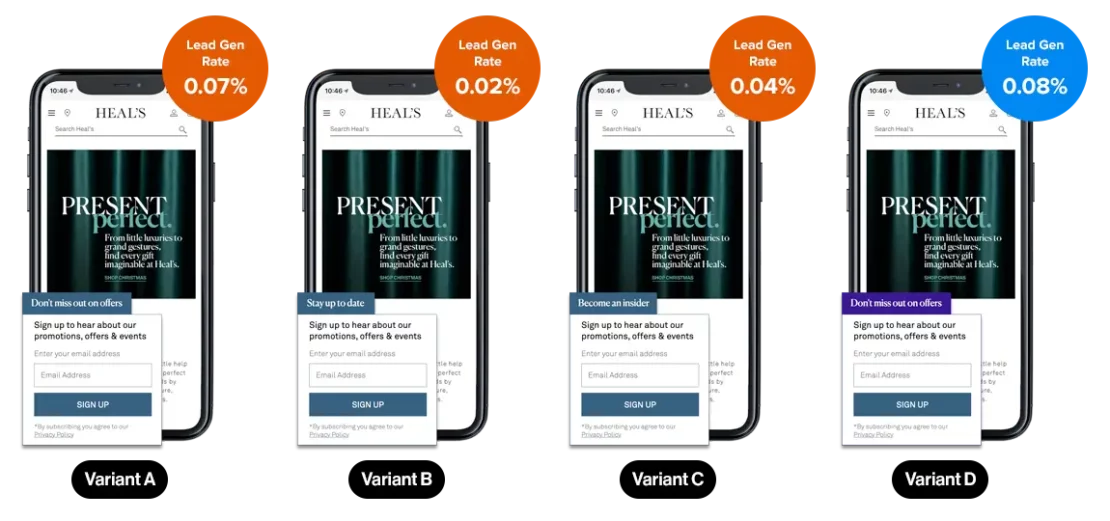
Heal’s used Yieldify A/B/n testing and learnt that their customers are more incentivized by discounts than belonging to an exclusive club. They tested CTA messaging on four different email opt-in forms – two promotional-based, and two exclusivity-based – and drove 60% more leads with promotional messaging.
Assess results, find new opportunities, revise strategy
13. Optimize your campaigns
Increasing your conversion rates with personalization is an ever-evolving ecommerce marketing strategy that adapts to changes in user behavior. So, once your tests reach completion, analyze performance and launch new campaigns to further optimize your website conversion rates.
For example, you may drive a 10% conversion rate uplift in an incremental test by embedding social proof to product pages. The social proof message is simple, “Customer favorite”, but “In high demand” or “x people viewed this today” could lift conversions even further. It’s only through testing that you’ll be able to find the most impactful social proof message.
On the other hand, another website change may have a negative impact – a poorly designed landing page, for example – but that doesn’t necessarily mean a different variation won’t lift conversion rates.
At Yieldify, our account managers provide analytical support to help clients optimize both high and low-performing campaigns, ensuring they drive maximum impact from their next round of tests.
14. Set best-performing campaigns to 100% of visitors
Finally, once you’ve run your tests to completion, it’s time to set your conversion-lifting campaigns to reach 100% of your website visitors. This one’s a no-brainer – by doubling your audience, you’ll maximize the extra revenue you get from lifting your conversion rate.
Ready to Increase your Conversion Rate?
If you don’t have the expertise to lift your conversion rates in-house, consider using a fully managed personalization platform like Yieldify. Want to learn more about how you can optimize your website? Read our post outlining 17 top conversion rate optimization tips for ecommerce.
If you’d like a preview of how you can optimize your CRO strategy with Yieldify, feel free to schedule a discovery call here. An advisor from our sales team will be delighted to share more.
Conversion rate FAQs
One of the most effective ways to increase conversion rates is by optimizing your website. Many ecommerce brands from SMB to Enterprise level use CRO tools like Yieldify to implement an effective conversion rate optimization strategy. To increase your conversion rates, you’ll need to:
– Set a clear strategy
– Analyze customer data
– Create personalized campaigns
– Continuously test website elements
– Adapt to customer needs
The average conversion rate for an ecommerce brand sits between 1.84%-3.71%. For B2B businesses, the average conversion rate is slightly higher than ecommerce, hovering between 2.23% – 4.31%. A good conversion rate is relative to the industry you’re operating in, but anything on the higher end of the averages for ecommerce or B2B is considered to be strong. Speak to Yieldify’s sales team to find out how you can improve your website conversion rate.
Marketers use a variety of digital marketing techniques – including personalization, A/B testing and heatmaps – to improve their website’s conversion rates. In ecommerce, many marketers struggle to lift conversion rates due to a lack of expertise. To overcome this challenge, conversion rate optimization tools like Yieldify, which includes a fully managed service team, help you to streamline customer journeys and lift conversions.
